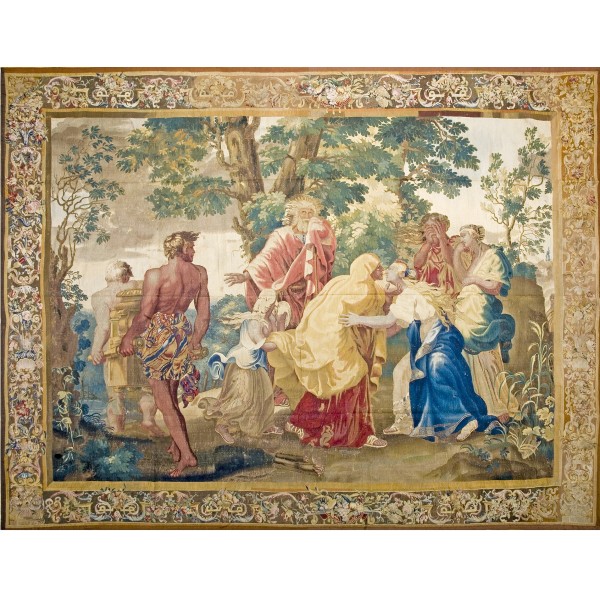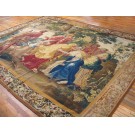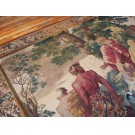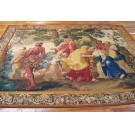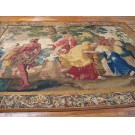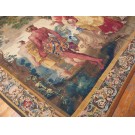17th Century Flanders Biblical Tapestry life of Moses
Antique Biblical tapestry Subject: Scene from a life of Moses Series, probably the reconciliation of Miriam and Zipporah Period: Late 16th / early 17th century. Origin: Brussels No makers mark Structure: Warp, wool, tan natural, Z-4-s, 19~20/in. Weft: wool Z-2, 60-64/in and Silk, Z-2 or z-3, 68-74/in Iconography: The likely cast of characters is follows: 1. Moses with halo in center, slightly to rear, presiding over the foreground event, the “horns†of the Old Testament text refer actually to rays of light. The goat-like protuberances of later art are really a literal and incorrect reading of the text. 2. The pair of figures on the left hefting an urn-like Ark of the Covenants one of which with a particularly fine back view and striped loincloth, are very Mannerist in style, indicating an origin in Italy, outside the Netherlands, in the circle of some early 16th century artist, possibly Giulio Romano, Mark Antonio Raimondi, Rosso Fiorentino or someone else of that trend. The figures are imported as a unit into the composition. Interestingly the two figures and their burden reappear in the 17th century French tapestry of the Triumph of Alexander after Charles Le Brun, but they have been swung around to nearly parallel the picture plane, although the rear orientation of the figure is still prominent. 3. The two female figure in the foreground may well be A. On the left Zipporah, the wife of Moses; and B. On the right Miriam, the sister of Moses. 4. A servant woman holds the train of Zipporah 5. Other Israelite women. Miriam and Zipporah are reconciled after a long period during which Miriam criticizes and speaks out against Moses and his policies as tribal leader. For this she is punished by God: her skin instead of being the brownish hue of the Israelites becomes white. Only when she ceases her dissent is she healed. This event may be depicted here. (cf Ex.. 4:14-16, Micoh 6:11, Deut. 24:9 for details). The life of Moses was depicted in various other sets from 1530's on ward with among others the following subjects: 1. Passage of The Red Sea 2. Brazen Serpent 3. Finding Gathering of Manna 4. Moses Receiving The Tables of The Law 5. Rebecca and Eleazar 6. Moses Prohibited from Setting Foot in The Promise Land 7. Worship of The Golden Calf 8. Joshua Defeats Amalek at the Battle of Rephidim Among the extant sets we may list: 1. The earliest a series of 9 panels (of 10), Brussels, 1530-40, designed by Bernard Van Orley and woven by Jan Gheetels, at Chateau Chateaudunt Somzee Coll. 2. Another set from the same cartoon also woven in Brussels, lacking a makers mark, 1545-1554, 9 panels (of 10) at the Kunsthistorisches Museum, Vienna. 3. Five panels (of 10), c. 1575 woven by Martin Reymbouts in Brussels now at the Chartres Musee De Beaux Arts, given in 1578 to the cathedral by Bishop Nicolas de Thou 4. Two panels (of 10) in the San Francisco Palace of The Legion of Honor; Brussels, c. 1550, possibly by Peter II van Aelst (unknown artist, but the same as that for the panel from the life of Jacob in the same museum, some of the same figures are even used) 5. 7 panels (of 10) from Oudenarde, 2nd half of the 16th century, now Monuments Historiques de France, much more traditional in style and lacking the Italianate mannerist elements. The whole effect is more planar and flat. The border could have come from a Verdure. The Life of Moses was popular later, and a set of indeterminate size, was woven in 1660’s in Brussels by Jan Parmentier with one panel, in square format, surviving. Apparently there are other panels surviving from The Life of Moses, but whether they constitute disjecta membra of true a series relating just Moses or whether they are single mosaic episodes along with other O.T. scenes in different cycles is open to question. They could belong with such non-mosaic scenes as Adam and Eve, Noah’s Ark, David and Goliath, Susanna and The Elders, David and Bathsheba, the Judgment of Solomon, etc. to illustrate various salient O.T. events. The border is slightly broken into at the top and bottom centre. The same effect, though more prominent, appears on a 12 Months of The Year series by Jan Franz van den Hecke, Brussels, c. 1590. It is possible that our piece may have some connection with his w
| Stock ID: | #18888 |
| General Rug Type: | European |
| Specific Rug Type: | Tapestry |
| Circa: | 1650 |
| Ground Color: | Other |
| Origin: | Belgium |
| Material: | Wool & Silk |
| Weave: | Flat Weave |
| Shape: | Rectangle |
| Width: | 10' ( 305 cm ) |
| Length: | 12' 8" ( 386 cm ) |
| Tearsheet Download |
